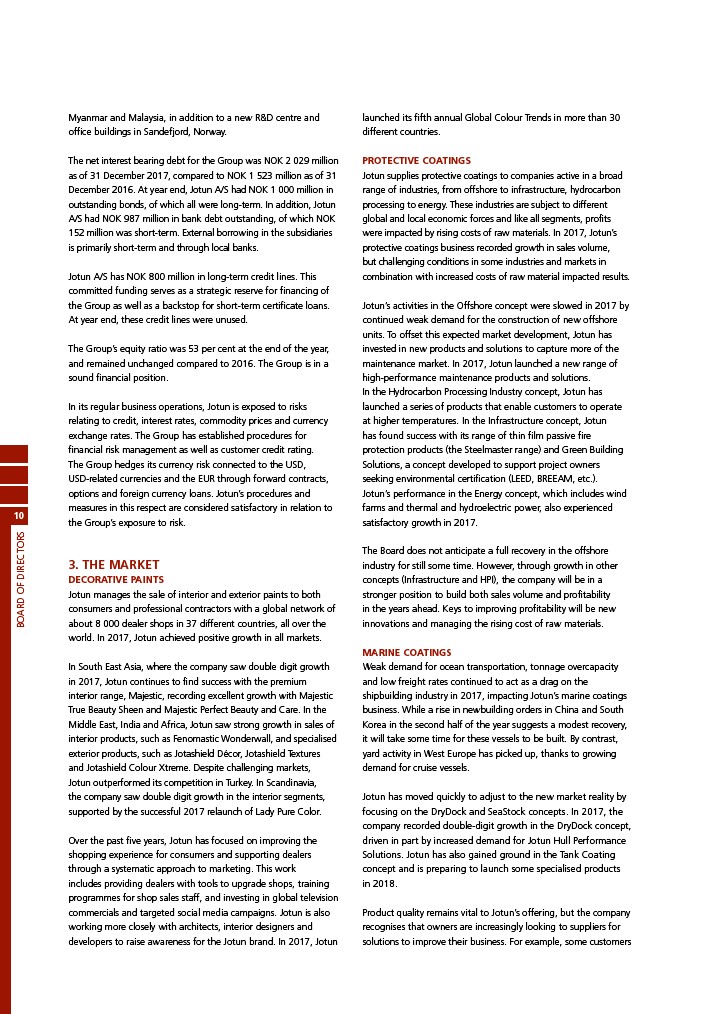
10
BOARD OF DIRECTORS
Myanmar and Malaysia, in addition to a new R&D centre and
office buildings in Sandefjord, Norway.
The net interest bearing debt for the Group was NOK 2 029 million
as of 31 December 2017, compared to NOK 1 523 million as of 31
December 2016. At year end, Jotun A/S had NOK 1 000 million in
outstanding bonds, of which all were long-term. In addition, Jotun
A/S had NOK 987 million in bank debt outstanding, of which NOK
152 million was short-term. External borrowing in the subsidiaries
is primarily short-term and through local banks.
Jotun A/S has NOK 800 million in long-term credit lines. This
committed funding serves as a strategic reserve for financing of
the Group as well as a backstop for short-term certificate loans.
At year end, these credit lines were unused.
The Group’s equity ratio was 53 per cent at the end of the year,
and remained unchanged compared to 2016. The Group is in a
sound financial position.
In its regular business operations, Jotun is exposed to risks
relating to credit, interest rates, commodity prices and currency
exchange rates. The Group has established procedures for
financial risk management as well as customer credit rating.
The Group hedges its currency risk connected to the USD,
USD-related currencies and the EUR through forward contracts,
options and foreign currency loans. Jotun’s procedures and
measures in this respect are considered satisfactory in relation to
the Group’s exposure to risk.
3. THE MARKET
DECORATIVE PAINTS
Jotun manages the sale of interior and exterior paints to both
consumers and professional contractors with a global network of
about 8 000 dealer shops in 37 different countries, all over the
world. In 2017, Jotun achieved positive growth in all markets.
In South East Asia, where the company saw double digit growth
in 2017, Jotun continues to find success with the premium
interior range, Majestic, recording excellent growth with Majestic
True Beauty Sheen and Majestic Perfect Beauty and Care. In the
Middle East, India and Africa, Jotun saw strong growth in sales of
interior products, such as Fenomastic Wonderwall, and specialised
exterior products, such as Jotashield Décor, Jotashield Textures
and Jotashield Colour Xtreme. Despite challenging markets,
Jotun outperformed its competition in Turkey. In Scandinavia,
the company saw double digit growth in the interior segments,
supported by the successful 2017 relaunch of Lady Pure Color.
Over the past five years, Jotun has focused on improving the
shopping experience for consumers and supporting dealers
through a systematic approach to marketing. This work
includes providing dealers with tools to upgrade shops, training
programmes for shop sales staff, and investing in global television
commercials and targeted social media campaigns. Jotun is also
working more closely with architects, interior designers and
developers to raise awareness for the Jotun brand. In 2017, Jotun
launched its fifth annual Global Colour Trends in more than 30
different countries.
PROTECTIVE COATINGS
Jotun supplies protective coatings to companies active in a broad
range of industries, from offshore to infrastructure, hydrocarbon
processing to energy. These industries are subject to different
global and local economic forces and like all segments, profits
were impacted by rising costs of raw materials. In 2017, Jotun’s
protective coatings business recorded growth in sales volume,
but challenging conditions in some industries and markets in
combination with increased costs of raw material impacted results.
Jotun’s activities in the Offshore concept were slowed in 2017 by
continued weak demand for the construction of new offshore
units. To offset this expected market development, Jotun has
invested in new products and solutions to capture more of the
maintenance market. In 2017, Jotun launched a new range of
high-performance maintenance products and solutions.
In the Hydrocarbon Processing Industry concept, Jotun has
launched a series of products that enable customers to operate
at higher temperatures. In the Infrastructure concept, Jotun
has found success with its range of thin film passive fire
protection products (the Steelmaster range) and Green Building
Solutions, a concept developed to support project owners
seeking environmental certification (LEED, BREEAM, etc.).
Jotun’s performance in the Energy concept, which includes wind
farms and thermal and hydroelectric power, also experienced
satisfactory growth in 2017.
The Board does not anticipate a full recovery in the offshore
industry for still some time. However, through growth in other
concepts (Infrastructure and HPI), the company will be in a
stronger position to build both sales volume and profitability
in the years ahead. Keys to improving profitability will be new
innovations and managing the rising cost of raw materials.
MARINE COATINGS
Weak demand for ocean transportation, tonnage overcapacity
and low freight rates continued to act as a drag on the
shipbuilding industry in 2017, impacting Jotun’s marine coatings
business. While a rise in newbuilding orders in China and South
Korea in the second half of the year suggests a modest recovery,
it will take some time for these vessels to be built. By contrast,
yard activity in West Europe has picked up, thanks to growing
demand for cruise vessels.
Jotun has moved quickly to adjust to the new market reality by
focusing on the DryDock and SeaStock concepts. In 2017, the
company recorded double-digit growth in the DryDock concept,
driven in part by increased demand for Jotun Hull Performance
Solutions. Jotun has also gained ground in the Tank Coating
concept and is preparing to launch some specialised products
in 2018.
Product quality remains vital to Jotun’s offering, but the company
recognises that owners are increasingly looking to suppliers for
solutions to improve their business. For example, some customers